© 2006-2015 Bob Hackett and Sander
Kingsepp
Revision 3
SENSUIKAN!
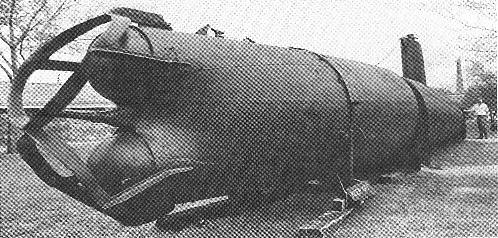
Midget Submarines in the Solomon Islands
1942
25 September 1942:
Captain (later Vice Admiral, posthumously) Harada Kaku’s (41) seaplane/submarine tender CHIYODA departs Kure for Truk unescorted. She
carries eleven Type A
midget submarines. CHIYODA's midgets are designated the Third "Divine
Dragon” Special Attack Unit. [1]
30 September 1942:
Off Piaanu Pass, Truk. At 0520 (K), LtCdr (later
Rear Admiral-Ret) Marvin G. Kennedy’s (USNA ’29) USS WAHOO (SS-238) sights CHIYODA at
12,000 yards, bearing 322 degrees true, on course 170 degrees true and
zigzagging, but WAHOO cannot close the range to attack. About 0900 (JST),
CHIYODA arrives safely at Truk.
Early October 1942:
Truk. Midget submarines conduct exercises S of
Fefan Island.

|
Solomon Islands
(U.S. Army)
7 October 1942:
A midget submarine base is established at Marovovo,
Guadalcanal. The garrison is landed by a destroyer and is comprised of one
platoon led by Lt Isobe.
14 October 1942:
CHIYODA departs Truk for Shortland, Bougainville and
delivers eight midget submarines the same day. The Shortland midget unit is
designated as the Chiyoda Base Unit. Later that evening, CHIYODA receives a
message about an approaching enemy convoy off Savo and departs to attack it with
the midgets. After it is learned that this is a Japanese convoy carrying
elements of the 38th "Sendai" Division, CHIYODA is recalled to Shortland. That
same day, fleet submarines I-172 and I-26 are ordered to proceed to an area S of
San Cristobal to recharge the batteries of Type A midget submarines from
CHIYODA. [2]
15 October 1942:
Kamimbo, Guadalcanal. About midnight, destroyer
SHIRAYUKI arrives from Shortland and unloads men and materials to begin
construction of a midget submarine base.
2 November 1942:
Shortland Islands anchorage. Captain (Rear Admiral,
posthumously) Ota Nobunosuke (47) I-20, I-16 and I-24's decks are loaded with a
midget submarine carried by CHIYODA. They are ordered to attack shipping in
Indispensable Strait off Guadalcanal.
3 November 1942:
At 0940 (JST), I-24 embarks Lt (j.g.) Mukai Yasuaki
and PO1C Sano Kyugoro's midget HA-12.
4 November 1942:
At 1000 (JST) , I-16 embarks Lt (j.g.) Yamaki Teiji
and PO1C Hashimoto Ryoichi’s midget submarine HA-30. I-16 and I-24 depart
Shortland for Indispensable Strait, Guadalcanal.
5 November 1942:
I-20 embarks Lt ( j.g.) Kunihiro Shinji and PO1C
Inoue Goro's midget submarine HA-11 and departs that evening. I-20 embarks HA-11
from CHIYODA like the others. The loading was complete by 1600 (JST).
6 November 1942:
CHIYODA returns to Truk.
7 November 1942:
At 0130 (JST), Lt ( j.g.) Kunihiro and his engineer
enter their midget. At 0145, I-20 dives and releases her submarine five minutes
later. I-20 returns to Truk. At 0430, Kunihiro commences to reconnoiter the
Lunga anchorage. After 0700, a destroyer is sighted. HA-11 dives to 66 ft and
changes her course, reducing the speed to 4 knots. At 0725, HA-11 resurfaces.
Kunihiro sights two enemy destroyers unloading supplies. He fires one Type 97
torpedo from 1,300 yards at the nearest one and immediately dives to 100 ft. At
0727, the lookouts from USS LANDSDOWNE (DD-486) spot a periscope and the
destroyer makes a sharp turn. The torpedo passes her stern and hits anchored
auxiliary MAJABA (AG-43). MAJABA is beached, but later salvaged. After 0736,
LANDSDOWNE makes a sonar contact and drops 11 depth-charges, followed by another
eleven at 0741 and 0748.
At 0850, Kunihiro notes his gyrocompass is malfunctioning. After some
confusion, the midget steadies at course 270. At 1100, HA-11 surfaces 5,500
yards off Savo to check its location, dives again and heads for Cape Esperance.
One hour later the Cape is sighted and Kunihiro changes his course for Marovovo.
At 1245, two airplanes force HA-11 to 100 foot depth. At 1345, the gyrocompass
breaks down. HA-11 continues the voyage on the surface. At 1430, the midget runs
aground in shallow waters off Marovovo. After all secret materials are salvaged,
Lt (j.g.) Kunihiro and PO1C Inoue scuttle their craft. Both sailors escape
ashore, becoming the first survivors of an IJN midget attack mission. [4]
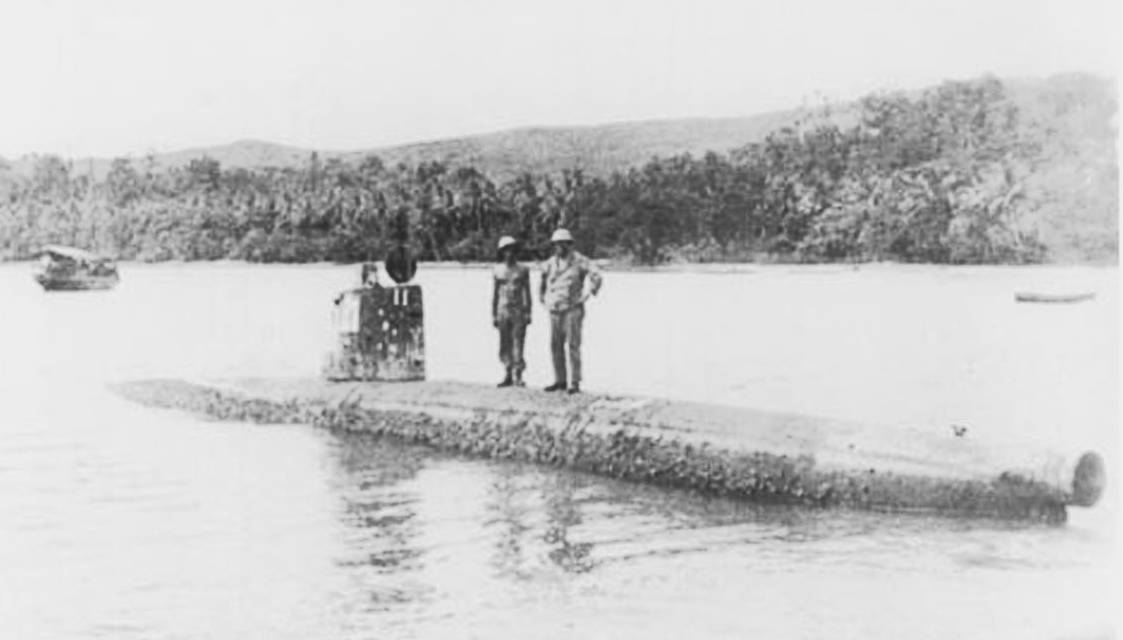 Ca. 1943: Two Seabees of a U.S. Naval Construction Battalion atop HA-11 off Marovovo.
(Photo © www.archaehistoria.org)
Ca. 1943: Two Seabees of a U.S. Naval Construction Battalion atop HA-11 off Marovovo.
(Photo © www.archaehistoria.org)
At 0300 (JST), I-16 arrives at her midget submarine launch area at
Guadalcanal. That same day, I-24 also patrols off Guadalcanal.
 Guadalcanal showing Marovovo, Cape Esperance and Lunga Point
(U.S. Army)
Guadalcanal showing Marovovo, Cape Esperance and Lunga Point
(U.S. Army)
11 November 1942:
Guadalcanal. At 0049 (JST), surfaced I-16 sights a
PT-boat and dives. At 0421, I-16 surfaces and launches Lt (j.g.) Yamaki Teiji
and PO1C Hashimoto Ryoichi’s midget submarine HA-30 about 10.8 miles from Cape
Esperance. During the launch, HA-30's rudder is damaged in a collision with the
supporting structure. A few minutes later, the midget submarine loses steering.
Yamaki surfaces and aborts the mission. Enroute to Kamimbo Bay, the crew sights
two enemy aircraft and scuttles their midget. Around 1600, both Yamaki and
Hashimoto reach shore at Marovovo. [3]
13 November 1942:
Truk. I-20 embarks her fourth midget submarine, Lt
( j.g.) Miyoshi Yoshiaki and PO1C Umeda Kiyoshi's HA-37 and departs for Lunga
Point, Guadalcanal. That same day, I-24 returns to Truk because Lt (j.g.)
Mukai's midget submarine HA-12 malfunctions.
15 November 1942:
Truk. I-24 embarks Mukai's repaired HA-12 from
CHIYODA and departs for Guadalcanal.
16 November 1942:
Shortland. I-16 embarks Lt (j.g.) Hoka Hiroshi and
PO Inokuma Shinsaku's midget submarine HA-10 and departs for Lunga Point.
18 November 1942:
Guadalcanal. At 0245 (JST), I-20 arrives at her
assigned launch area.
19 November 1942:
Guadalcanal. At 0300, I-20 launches Lt (j.g.)
Miyoshi's midget submarine HA-37 about 6 miles off Cape Esperance. A few minutes
later a serious oil leak develops from her steering system. Miyoshi decides to
continue his approach on the surface, but sights no targets. At 0655, HA-37 is
scuttled off Cape Esperance. Miyoshi and Umeda escape ashore.
 Type A Scuttled at Guadalcanal
(Naval Historical Center)
Type A Scuttled at Guadalcanal
(Naval Historical Center)
22 November 1942:
14 miles NW of Cape Esperance. At 2305, I-24
launches Lt (j.g.) Mukai's HA-12, but the midget submarine goes MIA thereafter.
26 November 1942:
Truk. I-20 embarks her fifth midget submarine, Lt (
j.g.) Tanaka Chiaki and CPO Mitani Mamoru's HA-8 and departs for Lunga Point.
28 November 1942:
Guadalcanal. At 0255, I-16 launches Lt ( j.g.)
Hoka's midget submarine HA-10 about 3,000 yards NE from Lunga Point. At 0816,
after penetrating a screen of destroyers, HA-10 fires one torpedo and damages
Cdr (later Rear Admiral) James S. Freeman’s (USNA ’21) ALCHIBA (AK-23) that is starting to
unload her cargo of aviation gasoline, bombs and ammunition. Freeman beaches
ALCHIBA to avoid her sinking. She continues to burn for four days. After the
attack, HA-10, Hoka and Inokuma go MIA. I-16 returns to Shortland.

|
ALCHIBA in 1941
(Official U.S. Navy Photograph)
7 December 1942:
Shortland. I-16 embarks midget submarine HA-22 and
departs for another attack off Guadalcanal.
1 December 1942:
Guadalcanal. I-20 arrives at her assigned launch
area.
Shortland. That same day, I-24 embarks Lt (j.g.) Tsuji Tomio and PO1C
Tsubokura Daiseiki's midget submarine HA-38.
2 December 1942:
Guadalcanal. At 2108 (JST), I-20 launches Lt (j.g.)
Tanaka's midget submarine HA-8 at 10.8 miles from Cape Esperance.
3 December 1942:
Guadalcanal. Lt (j.g.) Tanaka’s midget submarine
HA-8 sights several targets, including transports and destroyers. After being
beached for a short while, Tanaka fires both of his torpedoes at a transport;
one explosion is heard. HA-8 is chased by a destroyer, but receives no damage.
After the surfaced craft is swamped off Cape Esperance, the crew decides to
scuttle. Both Tanaka and Mitani reach shore.
7 December 1942:
Guadalcanal. At 0142, I-24 launches Lt (j.g.)
Tsuji's midget submarine HA-38 off Lunga Point. At 0659, HA-38 torpedoes beached
freighter ALCHIBA. One of her torpedoes misses, but the other hits the already
heavily damaged freighter portside near her engine room. ALCHIBA is later
repaired and returns to service in 1943 as an attack transport (AKA-6). HA-38 is
counter-attacked by SC-477, dropping a total of eight depth-charges. She goes
MIA thereafter. Japanese coastwatchers later report sighting a midget submarine
around 0810, which was chased by two destroyers towards the Tulagi area.
13 December 1942:
Guadalcanal. At 0448, I-16 launches Lt (j.g.) Kado
Yoshimi and PO Yahagi Toshio's midget submarine HA-22 about 10 miles off Savo
island. At dawn, Kado sights hospital ship USS SOLACE (AH-5) off Lunga Point. He
fires both torpedoes at a destroyer heading for the same area, but fails to
score. HA-22 is scuttled and Kado and Yahagi escape to Cape Esperance.

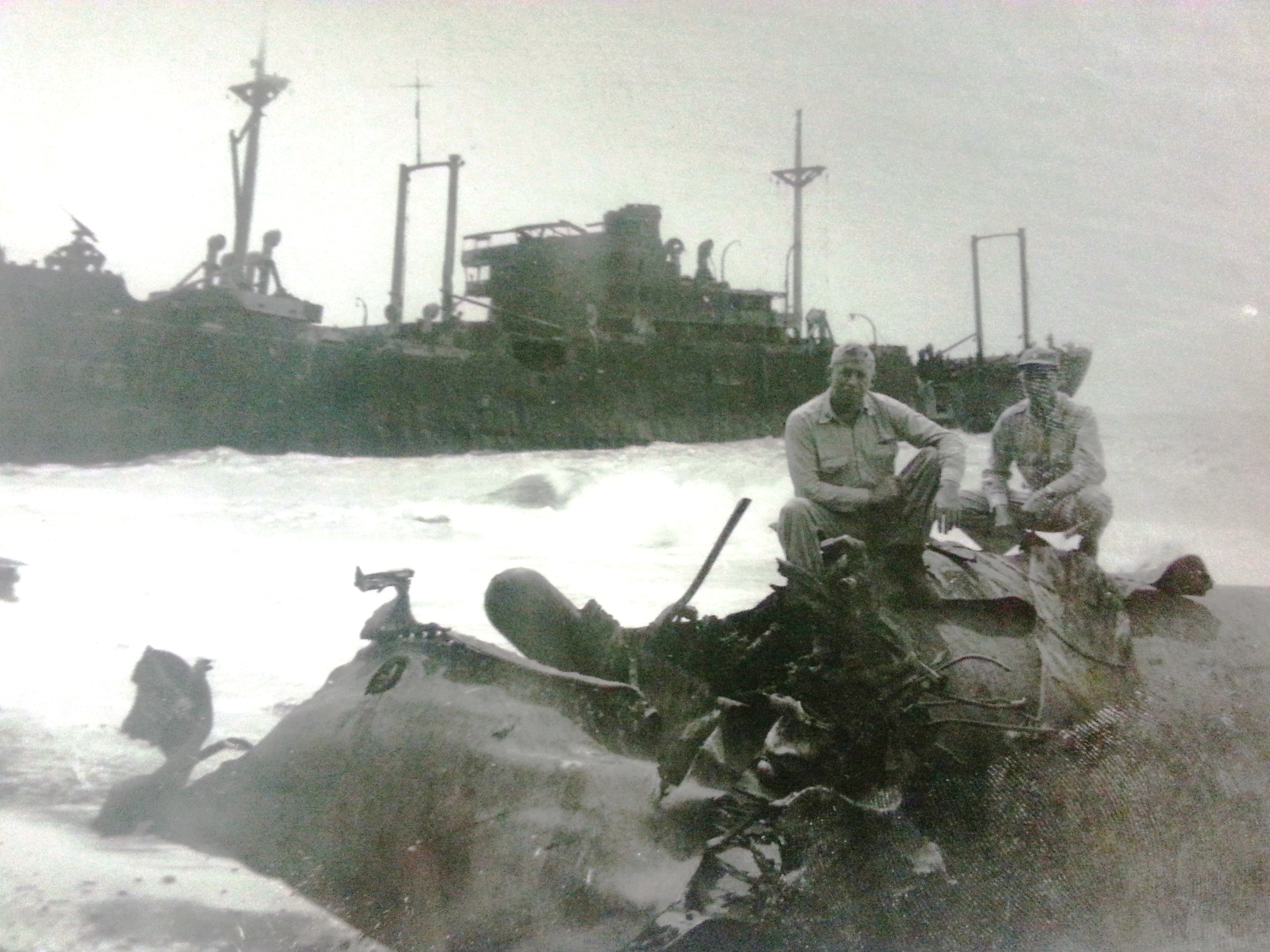
Type A Kai 1 near Tassafaronga Point, and USN officers atop smashed midget with a torpedo pointing upward, Guadalcanal ca. 1943
7 May 1943:
N coast of Guadalcanal. Submarine rescue vessel USS
ORTOLAN (ASR-5)(formerly AM-45) salvages a midget submarine in Visale Bay and
tows her to Kukum Bay, Guadalcanal. [5]
June 1943:
ORTOLAN delivers the salvaged midget submarine to Noumea,
New Caledonia.
26 July 1994:
New Zealand Author Ewan Stevenson goes to Guadalcanal and finds HA-11 still there and in good condition.
4 January 1945:
US Coast Guard cutter IRONWOOD (W-297) begins operations to raise an unidentified Japanese two-man midget submarine from about 30 feet of water off Cape Esperance. Divers, working from a small boat, use a water pressure hose and crowbars to clear a space under the bow and stern of the submarine. By 9 Jan, a 1.5” chain sling is rigged around the bow of the midget submarine. [6]
19 January 1945:
After retiring to Gavutu for ten days, IRONWOOD again anchors off Cape Esperance. By now, divers have completed rigging the submarine for lifting, connecting the chain around its bow and stern with a chain bridal.
20 January 1945 :
IRONWOOD is positioned alongside the sunken midget submarine. She lowers the main hoist over the starboard side and hooks it to the chain bridal. The cutter then raises the midget submarine to the surface and secures it alongside. IRONWOOD then tows it to Hutchinson's Creek, Florida Island, Solomons. The next day, IRONWOOD moves to a new anchorage where the midget submarine is transferred to an unidentified USN crane barge.
USCG IRONWOOD (W-297) Raises Midget Submarine Off Cape Esperance


Authors’ Notes:
[1] One of the midgets delivered on CHIYODA may have been HA-5 converted
to a training craft, which was later returned to Japan and discovered among the
other midget submarines in No. 4 dry-dock at Kure.
[2] It was planned to use the midgets to support the general attack on
American positions at Guadalcanal while attacking supply convoys off Florida and
Tulagi islands. Rear Admiral (later Vice Admiral) Ugaki canceled this operation. Unknown to Ugaki,
C-in-C, Sixth Fleet had dispatched I-26 to an area S of San Cristobal and the
I-172 to an area off Kamimbo to recharge the batteries of Type A midget
submarines that never arrived.
[3] Lt Yamaki Teiji was a member of the 31 May 1942, Sydney, Australia
Attack Group, but did not participate in the attack because of the death of his
crewman in a training operation before the operation.
[4] Some sources identify the midget submarine as Lt (j.g.) Tanaka’s
HA-8, others as Lt (j.g.) Hoka's HA-10 and still others as Lt (j.g.) Yamaki's
HA-30. Whichever she truly is, the "Guadalcanal midget submarine" is displayed
at the Nautilus Memorial Submarine Force Library and Museum in Groton, CT, one
of four such Type A midgets on display around the world.
During the war, at least one of the scuttled midget submarines is located
by the Allies and searched for code books and other items of intelligence value.
[5] Lt (j.g.) Kunihiro survived the war. He became skipper of submarines HA-101 and HA-109 and published his memoirs post-war.
[6] Although the identity of the midget submarine has not been confirmed, available Japanese data indicates it may be either HA-8, HA-22 or HA-37. See below:
Final Track Charts of Midget Submarines HA-8, HA-22 and HA-37 off Cape Esperance
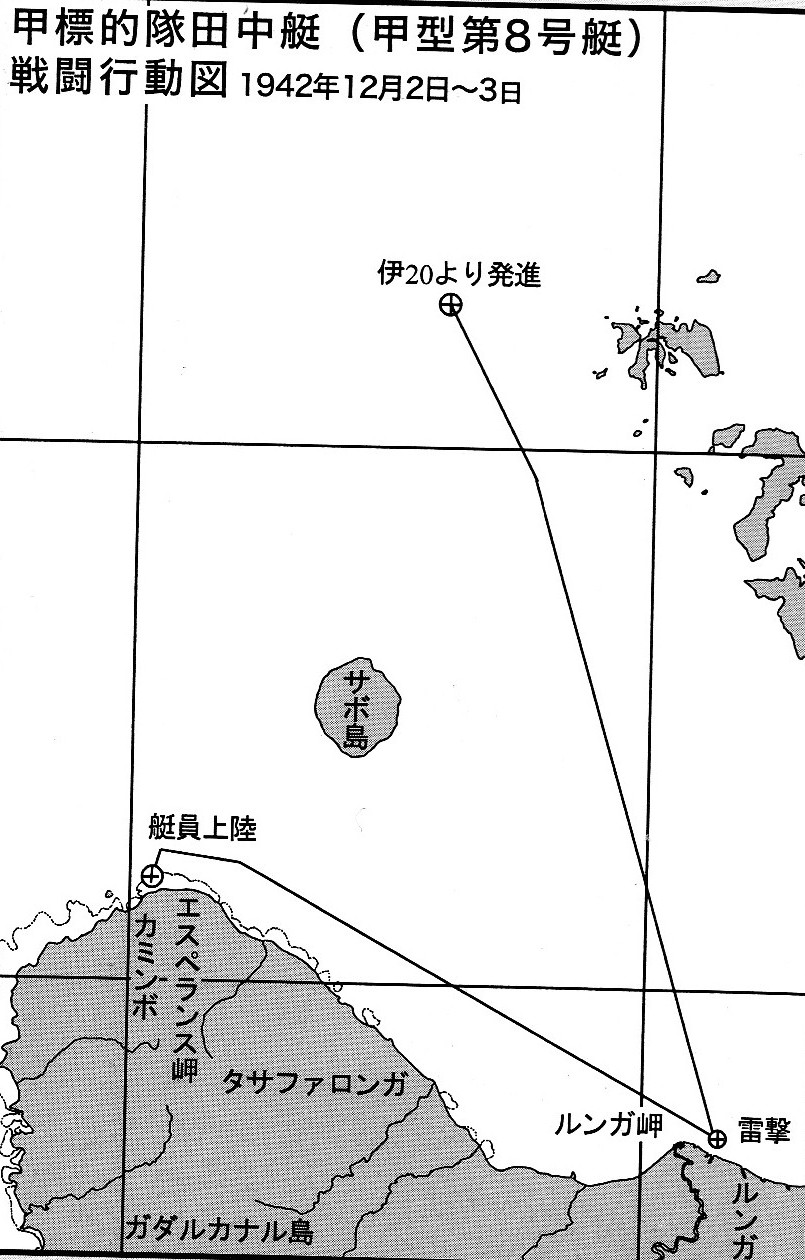

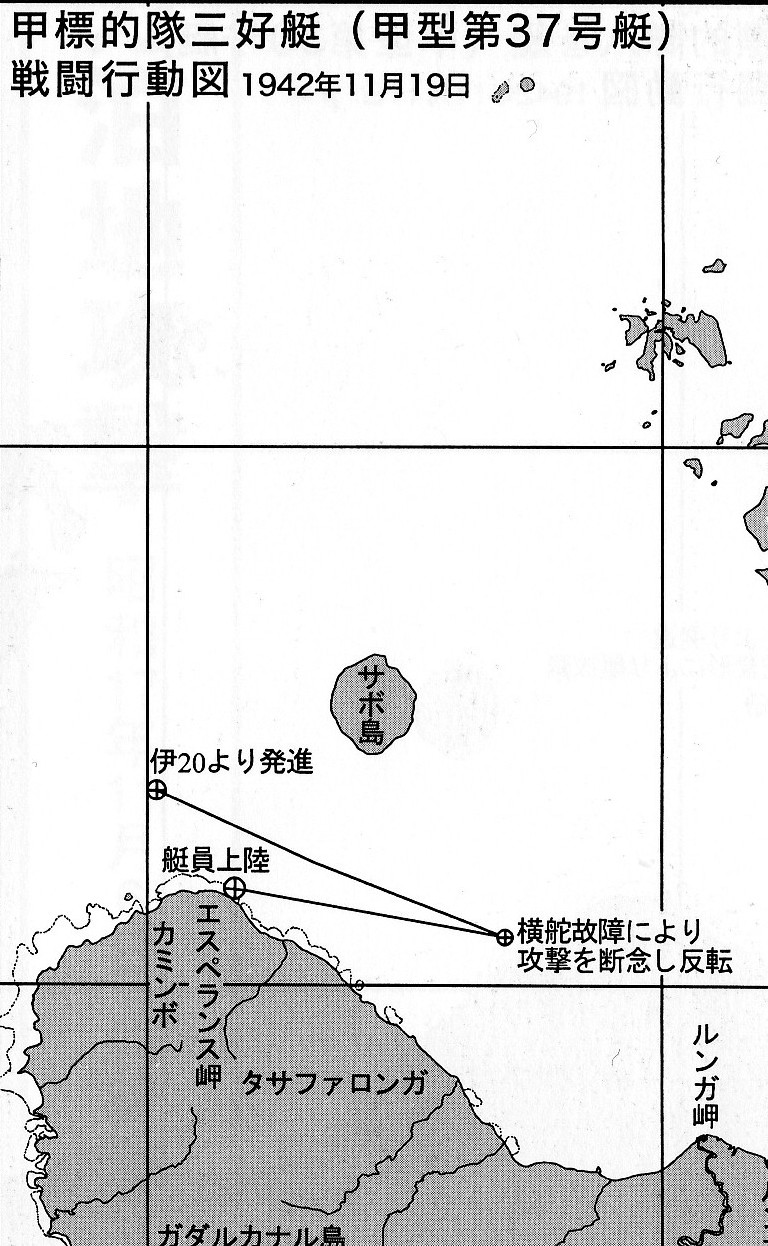
 Type A at Nautilus Memorial Submarine Force Museum
(U.S. Navy)
Thanks go to Australian diver/photojournalist Keven Denlay for proving the link to
Ewan Stevenson's "http://www.archaehistoria.org/" website. Thanks go to reader Chad Barnes for the photo of the midget with the upward pointing torpedo in Rev 3.
-Bob Hackett and Sander Kingsepp
Type A at Nautilus Memorial Submarine Force Museum
(U.S. Navy)
Thanks go to Australian diver/photojournalist Keven Denlay for proving the link to
Ewan Stevenson's "http://www.archaehistoria.org/" website. Thanks go to reader Chad Barnes for the photo of the midget with the upward pointing torpedo in Rev 3.
-Bob Hackett and Sander Kingsepp
Back to Submarine
Page


















